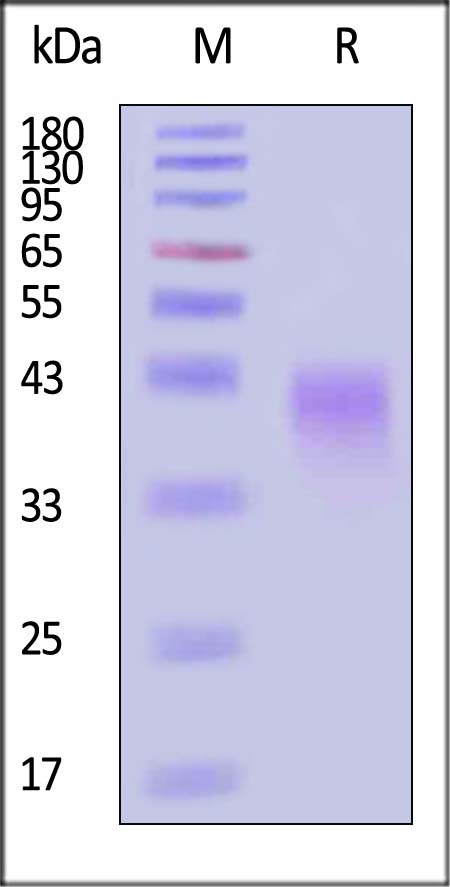分子别名(Synonym)
FGF8,Fibroblast growth factor 8,FGF-8,Androgen-induced growth factor,Heparin-binding growth factor 8 ,AIGF
表达区间及表达系统(Source)
Human / Mouse FGF-8b Protein, His Tag (FGB-H52H1) is expressed from human 293 cells (HEK293). It contains AA Gln 23 - Arg 215 (Accession # P55075-3).
Predicted N-terminus: Gln 23
Request for sequence
蛋白结构(Molecular Characterization)

This protein carries a polyhistidine tag at the C-terminus.
The protein has a calculated MW of 24.3 kDa. The protein migrates as 35-45 kDa when calibrated against Star Ribbon Pre-stained Protein Marker under reducing (R) condition (SDS-PAGE) due to glycosylation.
内毒素(Endotoxin)
Less than 0.1 EU per μg by the LAL method.
无菌(Sterility)
Negative
支原体(Mycoplasma)
Negative.
纯度(Purity)
>90% as determined by SDS-PAGE.
制剂(Formulation)
Lyophilized from 0.22 μm filtered solution in PBS, pH7.4 with trehalose as protectant.
Contact us for customized product form or formulation.
重构方法(Reconstitution)
Please see Certificate of Analysis for specific instructions.
For best performance, we strongly recommend you to follow the reconstitution protocol provided in the CoA.
存储(Storage)
For long term storage, the product should be stored at lyophilized state at -20°C or lower.
Please avoid repeated freeze-thaw cycles.
This product is stable after storage at:
- -20°C to -70°C for 24 months in lyophilized state;
- -70°C for 3 months under sterile conditions after reconstitution.
电泳(SDS-PAGE)

Human / Mouse FGF-8b Protein, His Tag on SDS-PAGE under reducing (R) condition. The gel was stained with Coomassie Blue. The purity of the protein is greater than 90% (With Star Ribbon Pre-stained Protein Marker).
活性(Bioactivity)-ELISA

Immobilized Human / Mouse FGF-8b Protein, His Tag (Cat. No. FGB-H52H1) at 5 μg/mL (100 μL/well) can bind Human FGF R3 (IIIb), Fc Tag (Cat. No. FGB-H5259) with a linear range of 0.039-2.5 μg/mL (QC tested).
Protocol
背景(Background)
FGF8 is identified as an androgen-induced growth factor secreted from a mammary carcinoma cell line and widely expressed during embryonic development. It has been shown to mediate embryonic epithelial-mesenchymal transition and to have a key role in gastrulation and early organization and differentiation of midbrain/hindbrain, pharyngeal, cardiac, urogenital and limb structures. During adulthood FGF8 expression is much more restricted but in hormonal cancers it becomes frequently activated. The FGF8 subfamily, including FGF8, FGF17 and FGF18, has been not only detected in prostate, breast cancer but also in hepatocellular carcinoma (HCC). FGF8, FGF17, and FGF18 are involved in autocrine and paracrine signaling in HCC and enhance the survival of tumor cells under stress conditions, malignant behavior, and neoangiogenesis. The vertebrate FGF8 gene produces multiple protein isoforms by alternative splicing. Two evolutionarily conserved spliceforms, FGF8a and FGF8b, exhibit distinct bioactivities, with Fgf8b having a more potent inductive activity due to higher affinity for FGF receptors.























































 膜杰作
膜杰作 Star Staining
Star Staining











